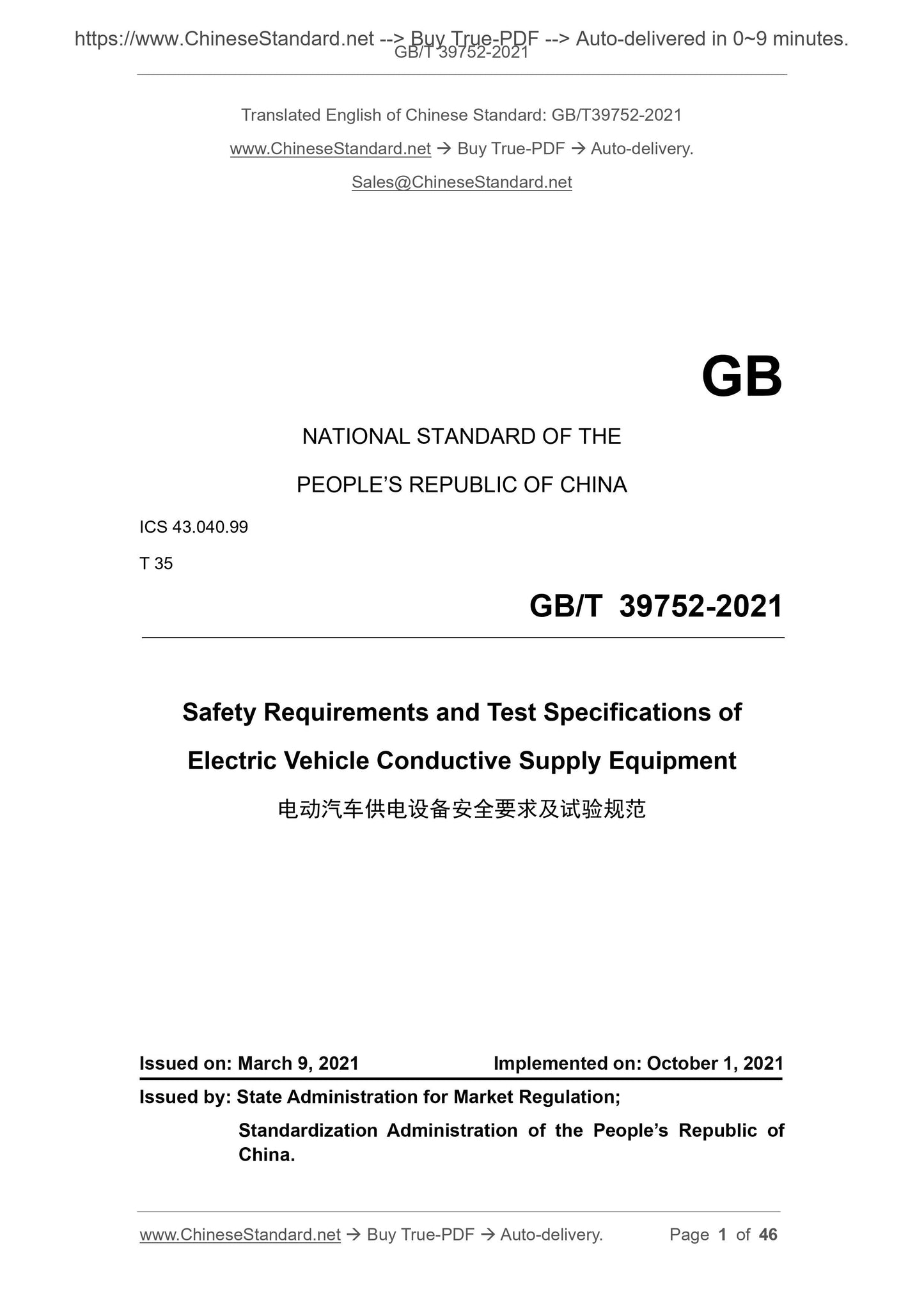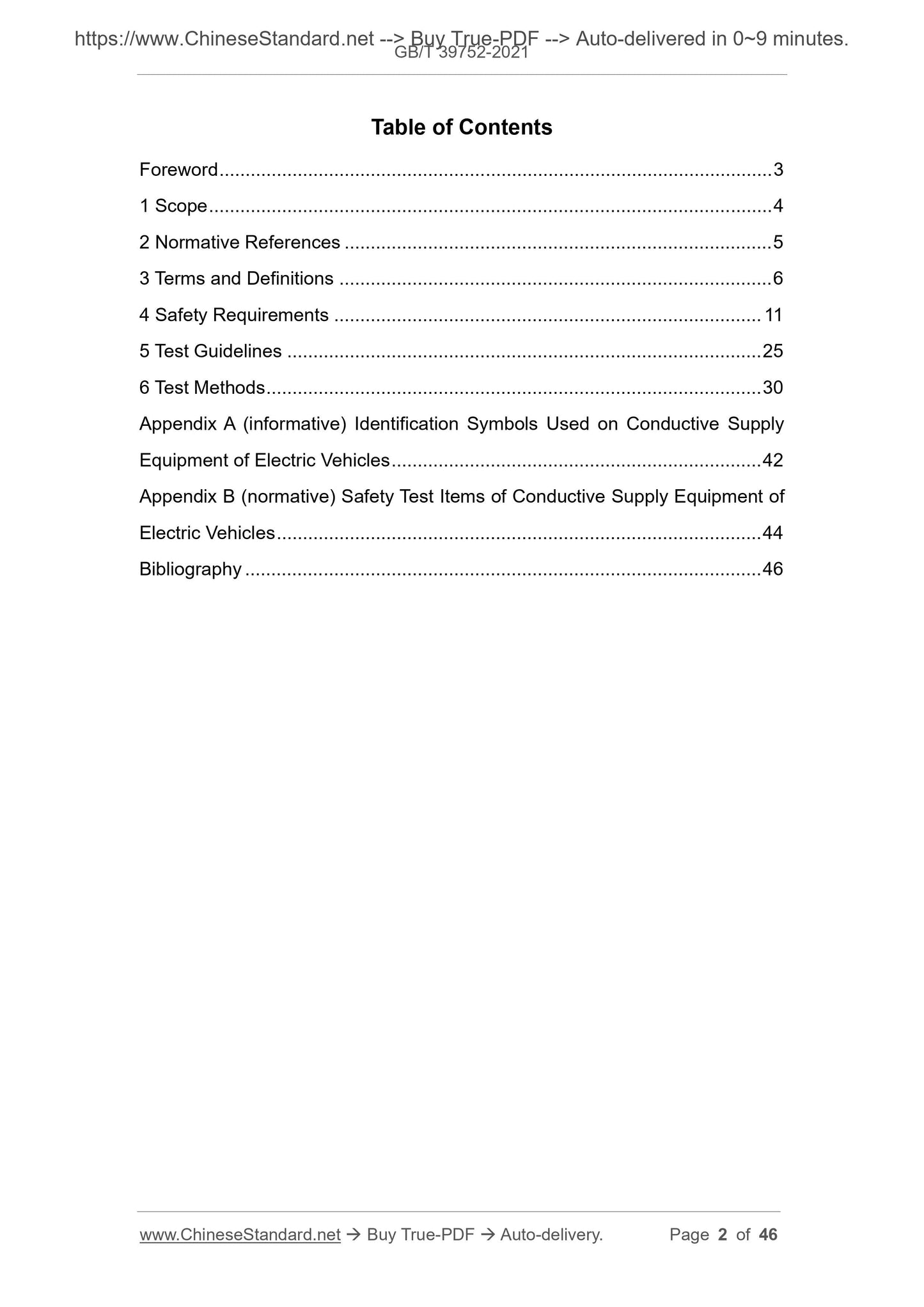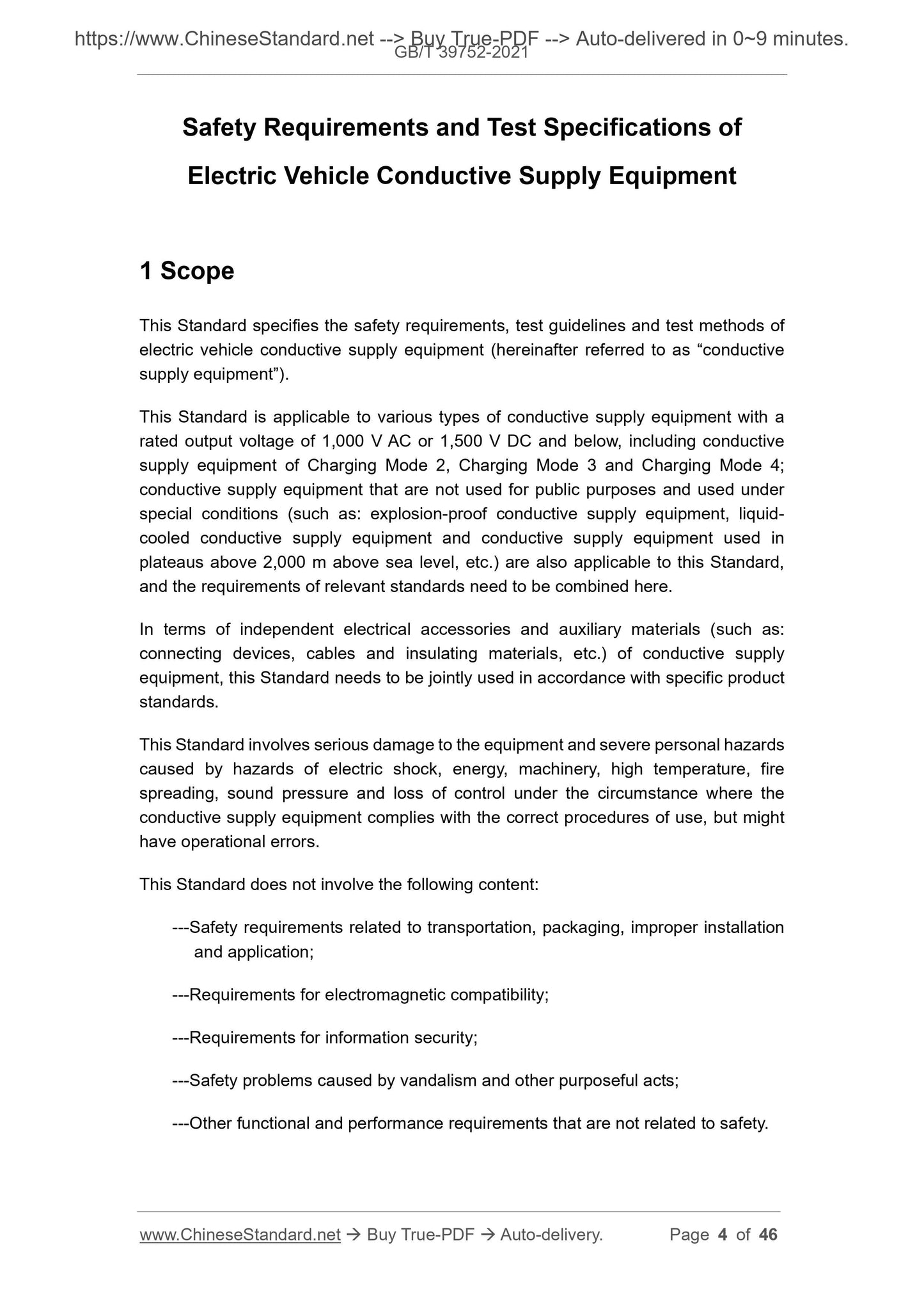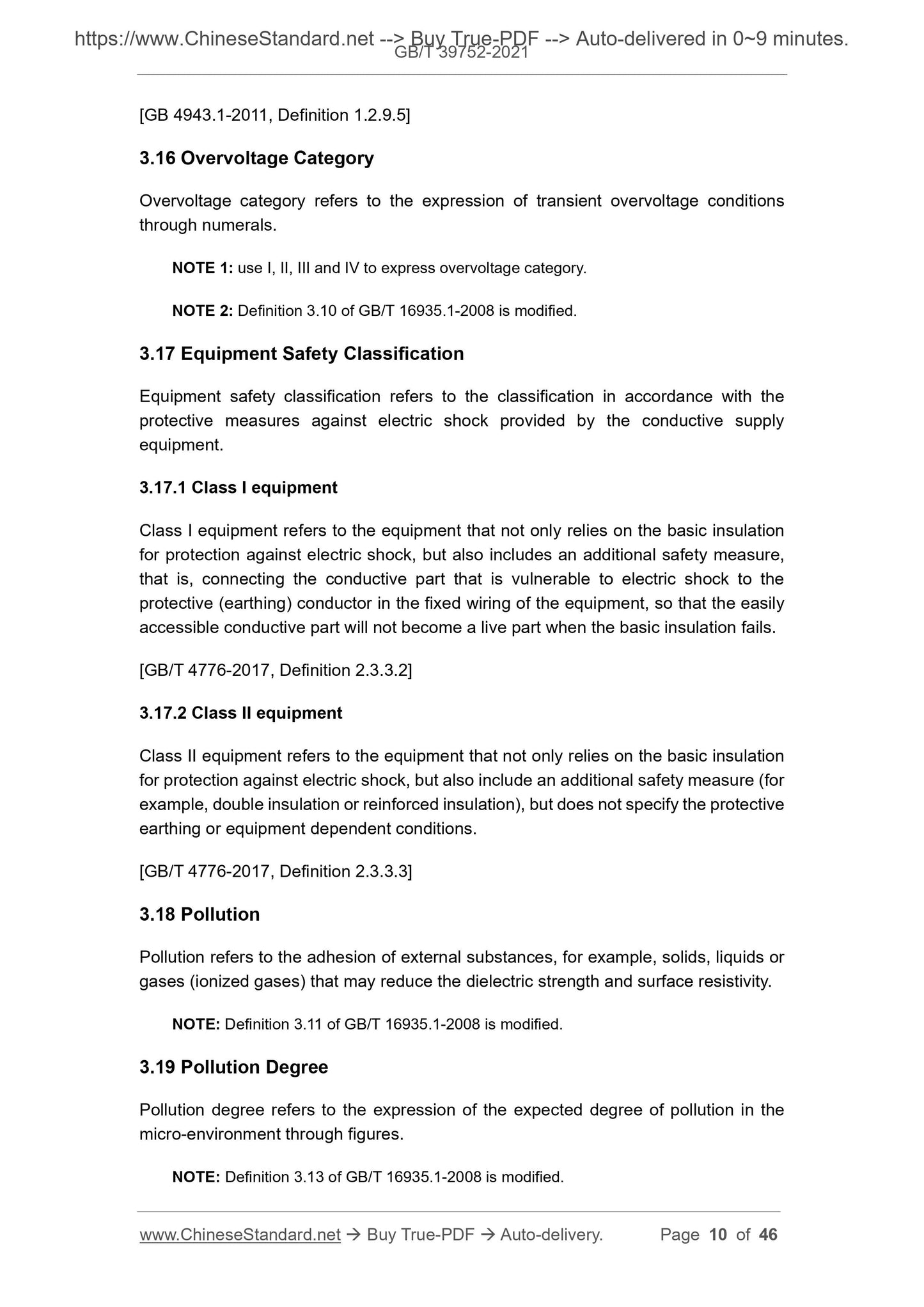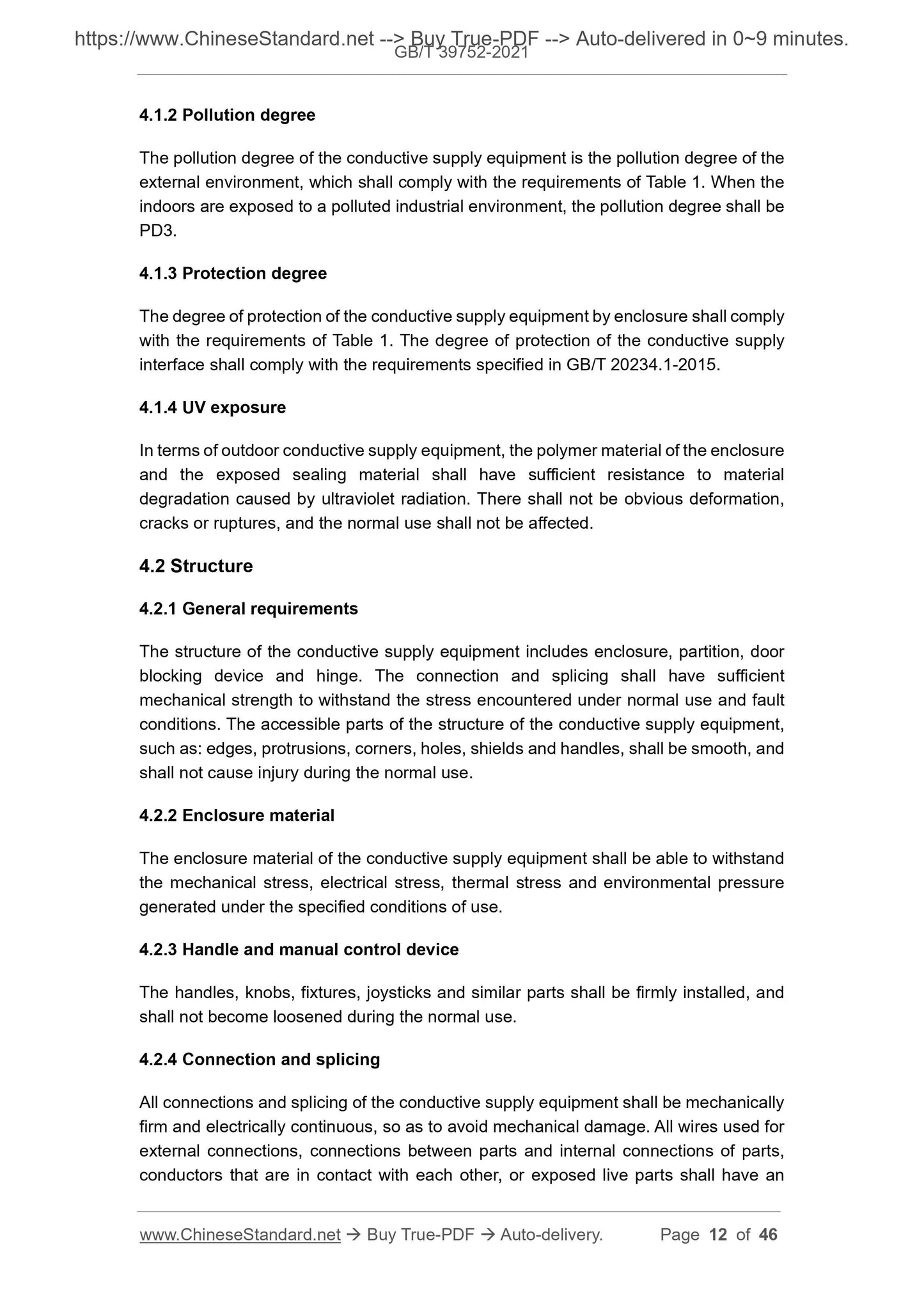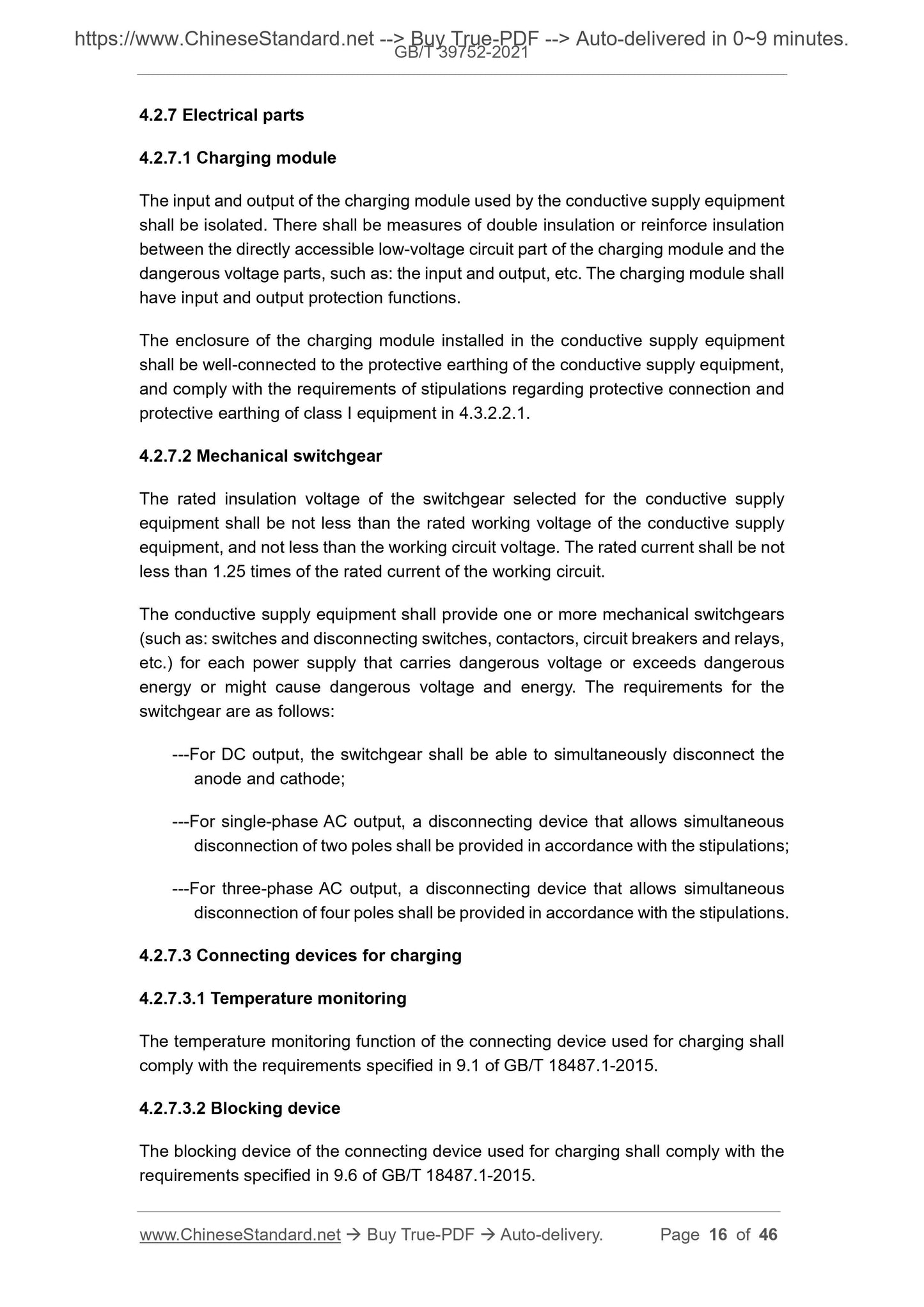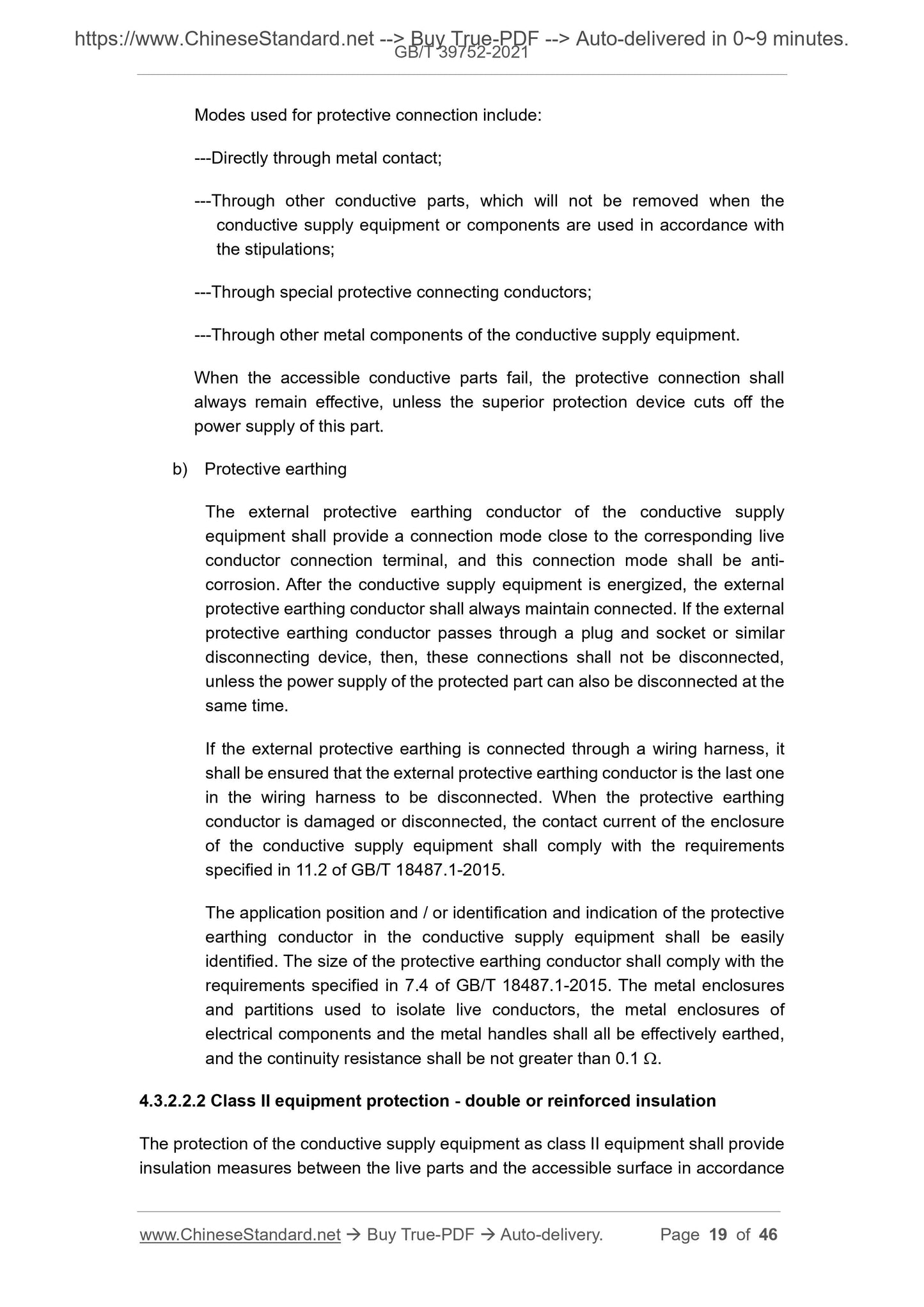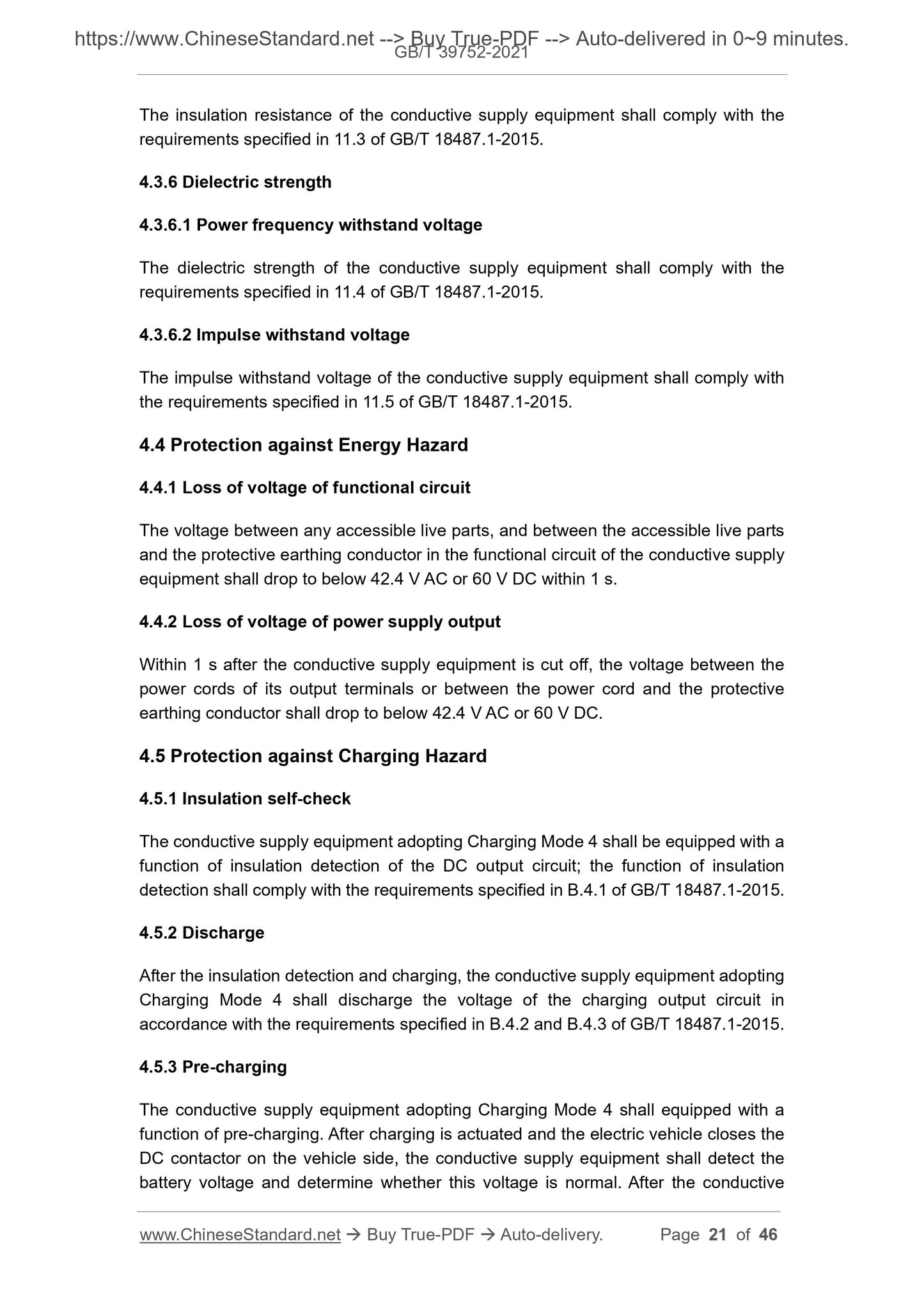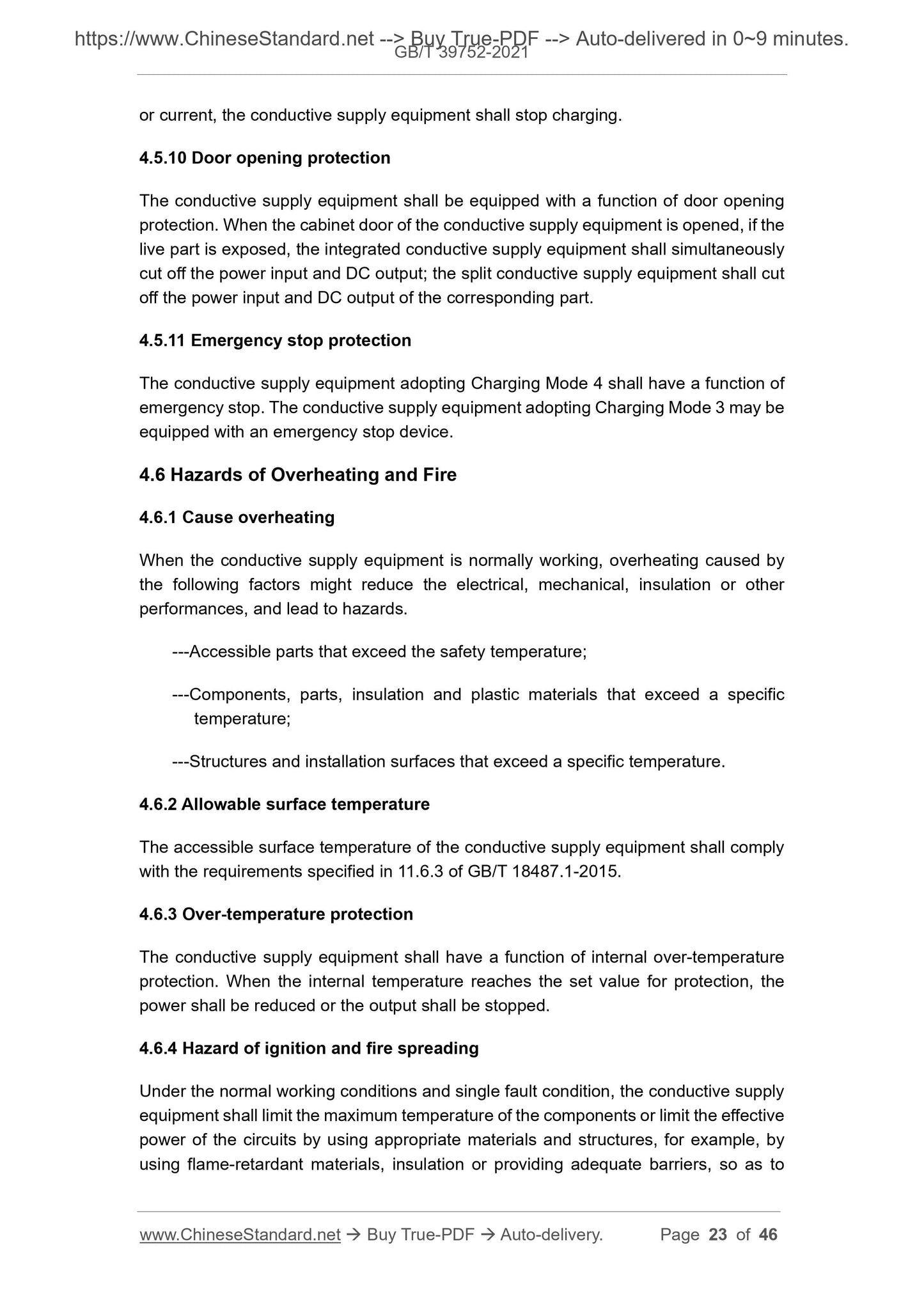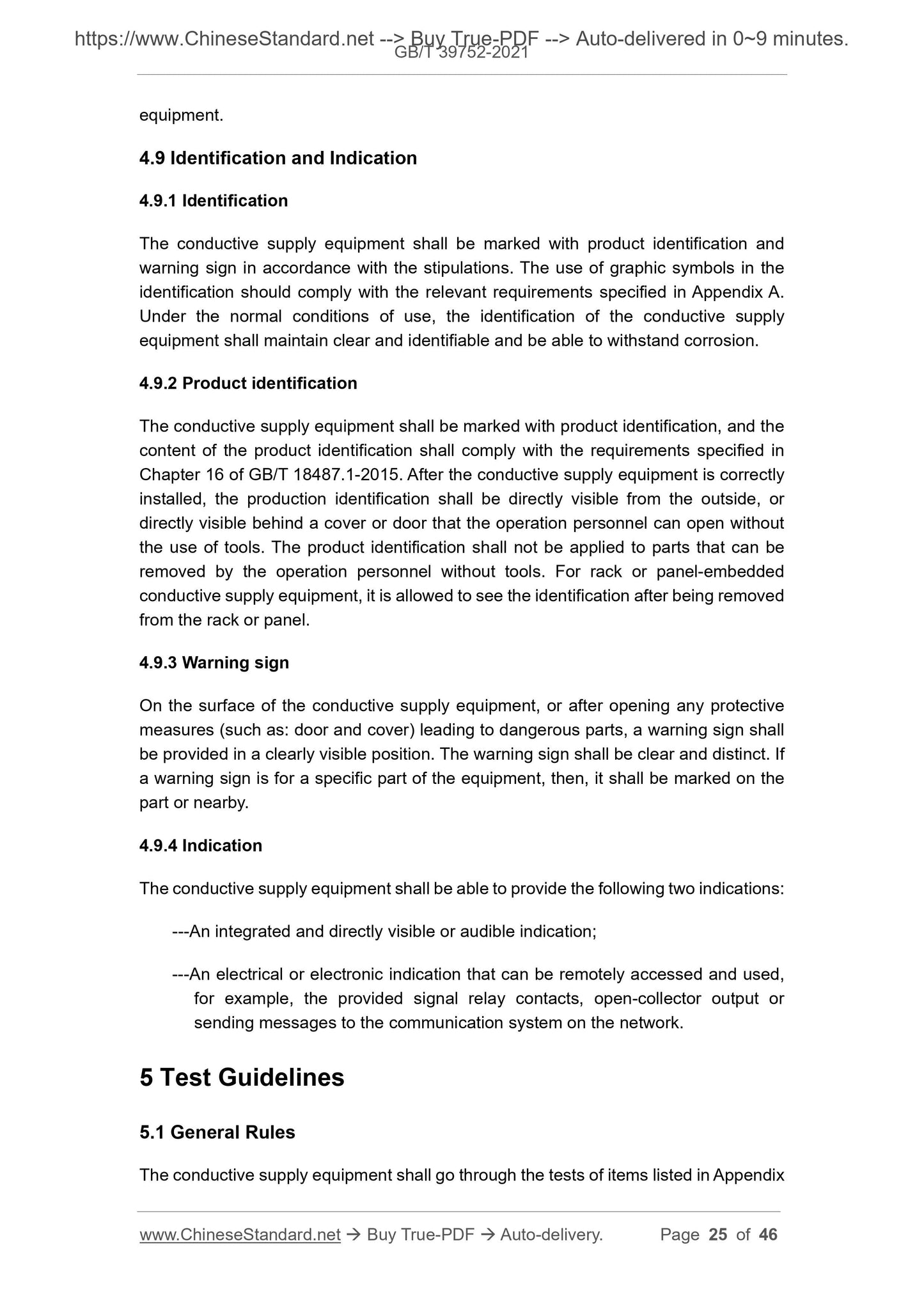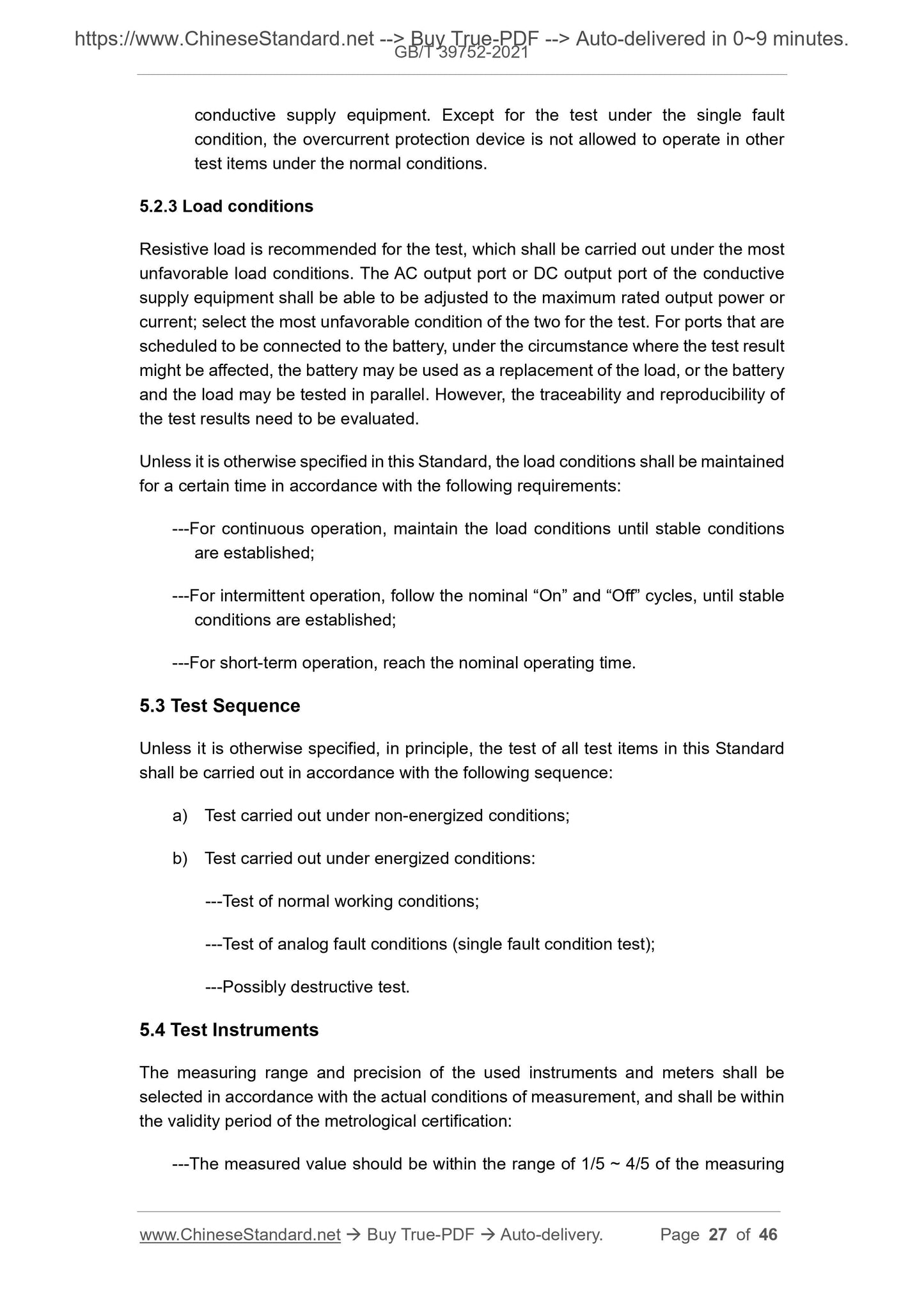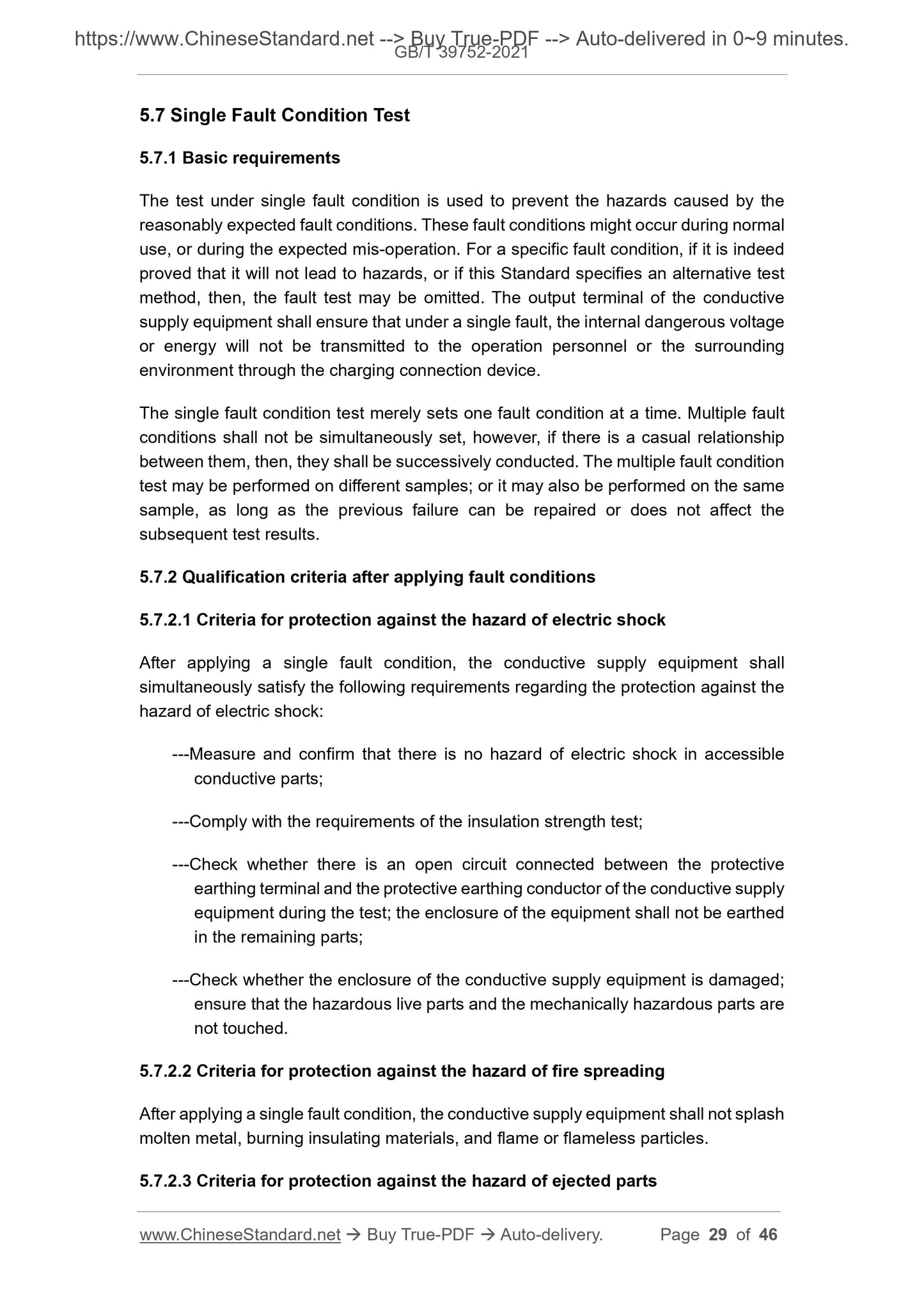1
/
of
12
PayPal, credit cards. Download editable-PDF and invoice in 1 second!
GB/T 39752-2021 English PDF (GB/T39752-2021)
GB/T 39752-2021 English PDF (GB/T39752-2021)
Regular price
$505.00
Regular price
Sale price
$505.00
Unit price
/
per
Shipping calculated at checkout.
Couldn't load pickup availability
GB/T 39752-2021: Safety Requirements and Test Specifications of Electric Vehicle Conductive Supply Equipment
Delivery: 9 seconds. Download (and Email) true-PDF + Invoice.Get Quotation: Click GB/T 39752-2021 (Self-service in 1-minute)
Newer / historical versions: GB/T 39752-2021
Preview True-PDF
Scope
This Standard specifies the safety requirements, test guidelines and test methods ofelectric vehicle conductive supply equipment (hereinafter referred to as “conductive
supply equipment”).
This Standard is applicable to various types of conductive supply equipment with a
rated output voltage of 1,000 V AC or 1,500 V DC and below, including conductive
supply equipment of Charging Mode 2, Charging Mode 3 and Charging Mode 4;
conductive supply equipment that are not used for public purposes and used under
special conditions (such as: explosion-proof conductive supply equipment, liquid-
cooled conductive supply equipment and conductive supply equipment used in
plateaus above 2,000 m above sea level, etc.) are also applicable to this Standard,
and the requirements of relevant standards need to be combined here.
In terms of independent electrical accessories and auxiliary materials (such as:
connecting devices, cables and insulating materials, etc.) of conductive supply
equipment, this Standard needs to be jointly used in accordance with specific product
standards.
This Standard involves serious damage to the equipment and severe personal hazards
caused by hazards of electric shock, energy, machinery, high temperature, fire
spreading, sound pressure and loss of control under the circumstance where the
conductive supply equipment complies with the correct procedures of use, but might
have operational errors.
This Standard does not involve the following content:
---Safety requirements related to transportation, packaging, improper installation
and application;
---Requirements for electromagnetic compatibility;
---Requirements for information security;
---Safety problems caused by vandalism and other purposeful acts;
---Other functional and performance requirements that are not related to safety.
[GB 4943.1-2011, Definition 1.2.9.5]
3.16 Overvoltage Category
Overvoltage category refers to the expression of transient overvoltage conditions
through numerals.
NOTE 1: use I, II, III and IV to express overvoltage category.
NOTE 2: Definition 3.10 of GB/T 16935.1-2008 is modified.
3.17 Equipment Safety Classification
Equipment safety classification refers to the classification in accordance with the
protective measures against electric shock provided by the conductive supply
equipment.
3.17.1 Class I equipment
Class I equipment refers to the equipment that not only relies on the basic insulation
for protection against electric shock, but also includes an additional safety measure,
that is, connecting the conductive part that is vulnerable to electric shock to the
protective (earthing) conductor in the fixed wiring of the equipment, so that the easily
accessible conductive part will not become a live part when the basic insulation fails.
[GB/T 4776-2017, Definition 2.3.3.2]
3.17.2 Class II equipment
Class II equipment refers to the equipment that not only relies on the basic insulation
for protection against electric shock, but also include an additional safety measure (for
example, double insulation or reinforced insulation), but does not specify the protective
earthing or equipment dependent conditions.
[GB/T 4776-2017, Definition 2.3.3.3]
3.18 Pollution
Pollution refers to the adhesion of external substances, for example, solids, liquids or
gases (ionized gases) that may reduce the dielectric strength and surface resistivity.
NOTE: Definition 3.11 of GB/T 16935.1-2008 is modified.
3.19 Pollution Degree
Pollution degree refers to the expression of the expected degree of pollution in the
micro-environment through figures.
NOTE: Definition 3.13 of GB/T 16935.1-2008 is modified.
4.1.2 Pollution degree
The pollution degree of the conductive supply equipment is the pollution degree of the
external environment, which shall comply with the requirements of Table 1. When the
indoors are exposed to a polluted industrial environment, the pollution degree shall be
PD3.
4.1.3 Protection degree
The degree of protection of the conductive supply equipment by enclosure shall comply
with the requirements of Table 1. The degree of protection of the conductive supply
interface shall comply with the requirements specified in GB/T 20234.1-2015.
4.1.4 UV exposure
In terms of outdoor conductive supply equipment, the polymer material of the enclosure
and the exposed sealing material shall have sufficient resistance to material
degradation caused by ultraviolet radiation. There shall not be obvious deformation,
cracks or ruptures, and the normal use shall not be affected.
4.2 Structure
4.2.1 General requirements
The structure of the conductive supply equipment includes enclosure, partition, door
blocking device and hinge. The connection and splicing shall have sufficient
mechanical strength to withstand the stress encountered under normal use and fault
conditions. The accessible parts of the structure of the conductive supply equipment,
such as: edges, protrusions, corners, holes, shields and handles, shall be smooth, and
shall not cause injury during the normal use.
4.2.2 Enclosure material
The enclosure material of the conductive supply equipment shall be able to withstand
the mechanical stress, electrical stress, thermal stress and environmental pressure
generated under the specified conditions of use.
4.2.3 Handle and manual control device
The handles, knobs, fixtures, joysticks and similar parts shall be firmly installed, and
shall not become loosened during the normal use.
4.2.4 Connection and splicing
All connections and splicing of the conductive supply equipment shall be mechanically
firm and electrically continuous, so as to avoid mechanical damage. All wires used for
external connections, connections between parts and internal connections of parts,
conductors that are in contact with each other, or exposed live parts shall have an
4.2.7 Electrical parts
4.2.7.1 Charging module
The input and output of the charging module used by the conductive supply equipment
shall be isolated. There shall be measures of double insulation or reinforce insulation
between the directly accessible low-voltage circuit part of the charging module and the
dangerous voltage parts, such as: the input and output, etc. The charging module shall
have input and output protection functions.
The enclosure of the charging module installed in the conductive supply equipment
shall be well-connected to the protective earthing of the conductive supply equipment,
and comply with the requirements of stipulations regarding protective connection and
protective earthing of class I equipment in 4.3.2.2.1.
4.2.7.2 Mechanical switchgear
The rated insulation voltage of the switchgear selected for the conductive supply
equipment shall be not less than the rated working voltage of the conductive supply
equipment, and not less than the working circuit voltage. The rated current shall be not
less than 1.25 times of the rated current of the working circuit.
The conductive supply equipment shall provide one or more mechanical switchgears
(such as: switches and disconnecting switches, contactors, circuit breakers and relays,
etc.) for each power supply that carries dangerous voltage or exceeds dangerous
energy or might cause dangerous voltage and energy. The requirements for the
switchgear are as follows:
---For DC output, the switchgear shall be able to simultaneously disconnect the
anode and cathode;
---For single-phase AC output, a disconnecting device that allows simultaneous
disconnection of two poles shall be provided in accordance with the stipulations;
---For three-phase AC output, a disconnecting device that allows simultaneous
disconnection of four poles shall be provided in accordance with the stipulations.
4.2.7.3 Connecting devices for charging
4.2.7.3.1 Temperature monitoring
The temperature monitoring function of the connecting device used for charging shall
comply with the requirements specified in 9.1 of GB/T 18487.1-2015.
4.2.7.3.2 Blocking device
The blocking device of the connecting device used for charging shall comply with the
requirements specified in 9.6 of GB/T 18487.1-2015.
Modes used for protective connection include:
---Directly through metal contact;
---Through other conductive parts, which will not be removed when the
conductive supply equipment or components are used in accordance with
the stipulations;
---Through special protective connecting conductors;
---Through other metal components of the conductive supply equipment.
When the accessible conductive parts fail, the protective connection shall
always remain effective, unless the superior protection device cuts off the
power supply of this part.
b) Protective earthing
The external protective earthing conductor of the conductive supply
equipment shall provide a connection mode close to the corresponding live
conductor connection terminal, and this connection mode shall be anti-
corrosion. After the conductive supply equipment is energized, the external
protective earthing conductor shall always maintain connected. If the external
protective earthing conductor passes through a plug and socket or similar
disconnecting device, then, these connections shall not be disconnected,
unless the power supply of the protected part can also be disconnected at the
same time.
If the external protective earthing is connected through a wiring harness, it
shall be ensured that the external protective earthing conductor is the last one
in the wiring harness to be disconnected. When the protective earthing
conductor is damaged or disconnected, the contact current of the enclosure
of the conductive supply equipment shall comply with the requirements
specified in 11.2 of GB/T 18487.1-2015.
The application position and / or identification and indication of the protective
earthing conductor in the conductive supply equipment shall be easily
identified. The size of the protective earthing conductor shall comply with the
requirements specified in 7.4 of GB/T 18487.1-2015. The metal enclosures
and partitions used to isolate live conductors, the metal enclosures of
electrical components and the metal handles shall all be effectively earthed,
and the continuity resistance shall be not greater than 0.1 .
4.3.2.2.2 Class II equipment protection - double or reinforced insulation
The protection of the conductive supply equipment as class II equipment shall provide
insulation measures between the live parts and the accessible surface in accordance
The insulation resistance of the conductive supply equipment shall comply with the
requirements specified in 11.3 of GB/T 18487.1-2015.
4.3.6 Dielectric strength
4.3.6.1 Power frequency withstand voltage
The dielectric strength of the conductive supply equipment shall comply with the
requirements specified in 11.4 of GB/T 18487.1-2015.
4.3.6.2 Impulse withstand voltage
The impulse withstand voltage of the conductive supply equipment shall comply with
the requirements specified in 11.5 of GB/T 18487.1-2015.
4.4 Protection against Energy Hazard
4.4.1 Loss of voltage of functional circuit
The voltage between any accessible live parts, and between the accessible live parts
and the protective earthing conductor in the functional circuit of the conductive supply
equipment shall drop to below 42.4 V AC or 60 V DC within 1 s.
4.4.2 Loss of voltage of power supply output
Within 1 s after the conductive supply equipment is cut off, the voltage between the
power cords of its output terminals or between the power cord and the protective
earthing conductor shall drop to below 42.4 V AC or 60 V DC.
4.5 Protection against Charging Hazard
4.5.1 Insulation self-check
The conductive supply equipment adopting Charging Mode 4 shall be equipped with a
function of insulation detection of the DC output circuit; the function of insulation
detection shall comply with the requirements specified in B.4.1 of GB/T 18487.1-2015.
4.5.2 Discharge
After the insulation detection and charging, the conductive supply equipment adopting
Charging Mode 4 shall discharge the voltage of the charging output circuit in
accordance with the requirements specified in B.4.2 and B.4.3 of GB/T 18487.1-2015.
4.5.3 Pre-charging
The conductive supply equipment adopting Charging Mode 4 shall equipped with a
function of pre-charging. After charging is actuated and the electric vehicle closes the
DC contactor on the vehicle side, the conductive supply equipment shall detect the
battery voltage and determine whether this voltage is normal. After the conductive
or current, the conductive supply equipment shall stop charging.
4.5.10 Door opening protection
The conductive supply equipment shall be equipped with a function of door opening
protection. When the cabinet door of the conductive supply equipment is opened, if the
live part is exposed, the integrated conductive supply equipment shall simultaneously
cut off the power input and DC output; the split conductive supply equipment shall cut
off the power input and DC output of the corresponding part.
4.5.11 Emergency stop protection
The conductive supply equipment adopting Charging Mode 4 shall have a function of
emergency stop. The conductive supply equipment adopting Charging Mode 3 may be
equipped with an emergency stop device.
4.6 Hazards of Overheating and Fire
4.6.1 Cause overheating
When the conductive supply equipment is normally working, overheating caused by
the following factors might reduce the electrical, mechanical, insulation or other
performances, and lead to hazards.
---Accessible parts that exceed the safety temperature;
---Components, parts, insulation and plastic materials that exceed a specific
temperature;
---Structures and installation surfaces that exceed a specific temperature.
4.6.2 Allowable surface temperature
The accessible surface temperature of the conductive supply equipment shall comply
with the requirements specified in 11.6.3 of GB/T 18487.1-2015.
4.6.3 Over-temperature protection
The conductive supply equipment shall have a function of internal over-temperature
protection. When the internal temperature reaches the set value for protection, the
power shall be reduced or the output shall be stopped.
4.6.4 Hazard of ignition and fire spreading
Under the normal working conditions and single fault condition, the conductive supply
equipment shall limit the maximum temperature of the components or limit the effective
power of the circuits by using appropriate materials and structures, for example, by
using flame-retardant materials, insulation or providing adequate barriers, so as to
equipment.
4.9 Identification and Indication
4.9.1 Identification
The conductive supply equipment shall be marked with product identification and
warning sign in accordance with the stipulations. The use of graphic symbols in the
identification should comply with the relevant requirements specified in Appendix A.
Under the normal conditions of use, the identification of the conductive supply
equipment shall maintain clear and identifiable and be able to withstand corrosion.
4.9.2 Product identification
The conductive supply equipment shall be marked with product identification, and the
content of the product identification shall comply with the requirements specified in
Chapter 16 of GB/T 18487.1-2015. After the conductive supply equipment is correctly
installed, the production identification shall be directly visible from the outside, or
directly visible behind a cover or door that the operation personnel can open without
the use of tools. The product identification shall not be applied to parts that can be
removed by the operation personnel without tools. For rack or panel-embedded
conductive supply equipment, it is allowed to see the identification after being removed
from the rack or panel.
4.9.3 Warning sign
On the surface of the conductive supply equipment, or after opening any protective
measures (such as: door and cover) leading to dangerous parts, a warning sign shall
be provided in a clearly visible position. The warning sign shall be clear and distinct. If
a warning sign is for a specific part of the equipment, then, it shall be marked on the
part or nearby.
4.9.4 Indication
The conductive supply equipment shall be able to provide the following two indications:
---An integrated and directly visible or audible indication;
---An electrical or electronic indication that can be remotely accessed and used,
for example, the provided signal relay contacts, open-collector output or
sending messages to the communication system on the network.
Basic Data
| Standard ID | GB/T 39752-2021 (GB/T39752-2021) |
| Description (Translated English) | Safety Requirements and Test Specifications of Electric Vehicle Conductive Supply Equipment |
| Sector / Industry | National Standard (Recommended) |
| Classification of Chinese Standard | T35 |
| Word Count Estimation | 34,386 |
| Issuing agency(ies) | State Administration for Market Regulation, China National Standardization Administration |
Share
